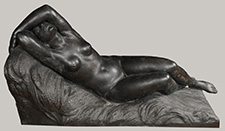Reclining Nude (Plenitude, Spring)

The presence of women is a constant feature in Frederic Marès' oeuvre, ranging from religious works to the figures and busts featuringNoucentisme-style idealism. However, in this reclining nude the sculptor draws closer to the most sensual portrayals of the female figure.
The forerunners of this sculpture can be found in the works of nude and standing women like the ones that appear in Rhythm, Plenitude(1920) and Nude - presented at the 1926 National Fine Arts Exhibition - and in some reliefs dating from the 1930s.
The nude woman that Marès portrays is lying down in a wheat field, but Marès refused to treat nature as a mere backdrop and instead fosters the idea of globality among the elements by not just using the wheat as the bed for the figure but also by having her intertwine her hands in the ears of wheat. The portrayal of ripe wheat, the twisting of the body and the position of the arms half-hiding the face all enhance the voluptuousness of the figure, a feeling which comes to the fore in the sub-titles of Plenitude and Spring with which the work is known.
Marès submitted this sculpture rendered in bronze to the National Fine Arts Exhibition in Madrid in 1936, and again after the Civil War in the 1941 edition. He won a second place medal in the latter edition. It later took part in other competitions, which demonstrates that the aesthetic taste in official circles had changed little.
In 1982 Marès donated this sculpture to the city of Barcelona to be installed in the vestibule of the Town Hall, and he cast another one, which is the version on display in the museum.


